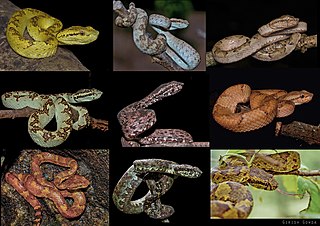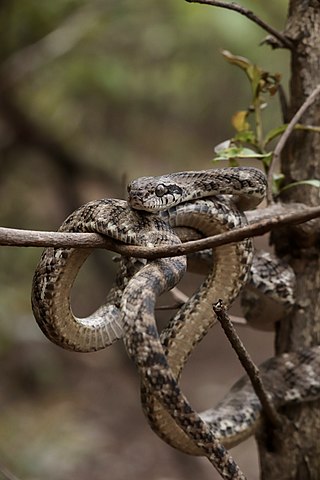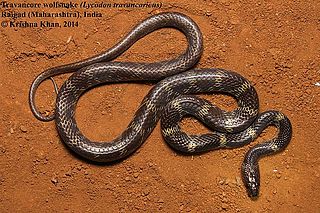
The Eastern Ghats are a discontinuous range of mountains along India's eastern coast. The Eastern Ghats pass through Odisha, Andhra Pradesh to Tamil Nadu in the south passing some parts of Karnataka as well as Telangana. They are eroded and cut through by four major rivers of peninsular India, viz., Mahanadi, Godavari, Krishna, and Kaveri. Deomali with 1672 m height is the tallest point in Odisha. Arma Konda/Jindhagada Peak with 1680 m is the highest point in Andhra Pradesh. BR hill range located in Karnataka is the tallest hill range in Eastern Ghats with many peaks above 1750 m height. Kattahi Betta in BR hills with the height of 1822 m is the tallest peak in Eastern Ghats. Thalamalai hill range in Tamil Nadu is the second tallest hill range. Araku range is the third tallest hill range.

Boiga is a large genus of rear-fanged, mildly venomous snakes, known commonly as cat-eyed snakes or simply cat snakes, in the family Colubridae. Species of the genus Boiga are native to southeast Asia, India, and Australia, but due to their extremely hardy nature and adaptability, have spread to many other suitable habitats around the world. There are 38 recognized species in the genus. According to the study done by Jiří Smíd regarding Old World cat snakes, the ancestor of the cat snake originated in Africa, from where it diversified and expanded to other countries. Despite this diversity however, the different species have very similar needs in terms of temperature and precipitation.

Craspedocephalusmalabaricus, commonly known as Malabar pit viper, Malabar rock pit viper, or rock viper, is a venomous pit viper species endemic to the High-moderate elevations of western ghats of southwestern India.Recently this species complex was splited to three different species, Craspedocephalus malabaricus, Craspedocephalus travancoricus(South of shengottai gap), Craspedocephalus anamallensis(south of palghat gap upto North of shengottai gap).

Boiga andamanensis, known commonly as the Andaman cat snake, is a species of rear-fanged snake in the family Colubridae. The species is endemic to the Andaman Islands.

Boiga beddomei, commonly known as Beddome's cat snake, is a species of rear-fanged snake in the family Colubridae. The species is endemic to the Western Ghats of India, in Maharashtra, Gujarat and Goa states.

Boiga ceylonensis is a species of rear-fanged, mildly venomous, nocturnal, arboreal colubrid snake endemic to Sri Lanka.

Boiga cyanea, commonly known as the Green cat snake, is a colubrid snake species found in South Asia, China and South-east Asia.

Boiga cynodon, commonly known as the dog-toothed cat snake, is a nocturnal species of rear-fanged colubrid snake endemic to Asia.
Boiga dightoni, commonly known as Dighton's catsnake, the Pirmad cat snake, and the Travancore cat snake, is a species of rear-fanged mildly venomous snake in the family Colubridae. The species is endemic to the Western Ghats of India.

Boiga forsteni, also known as Forsten's cat snake, is a species of mildly venomous rear-fanged colubrid endemic to South Asia.

Lycodon travancoricus, commonly known as the Travancore wolf snake, is a species of colubrid snake endemic to south India.
Uropeltis dindigalensis, commonly known as the Dindigul uropeltis and the Sirumalai Hills earth snake, is a species of snake in the family Uropeltidae. The species is endemic to Sirumalai and surrounding hill ranges of the southern Eastern Ghats, in Dindigul district of Tamil Nadu state in South India.

Bothrops bilineatus, also known as the two-striped forest-pitviper, parrotsnake, Amazonian palm viper, or green jararaca, is a highly venomous pit viper species found in the Amazon region of South America. Two subspecies are currently recognized, including the nominate subspecies described here. A pale green arboreal species that may reach 1 m (3.3 ft) in length, it is an important cause of snakebite throughout the entire Amazon region.

Boiga philippina, also known as the tawny cat eyed snake or Philippine cat snake, a species of rear-fanged colubrid snake that is endemic to the Philippines.

Boiga kraepelini, commonly known as the square-headed cat snake, Kelung cat snake, or Taiwanese tree snake is a species of mildly venomous, rear-fanged snake in the family Colubridae. The species is endemic to East Asia and Southeast Asia. Its specific name, kraepelini, honours Karl Kraepelin, a German naturalist. The common name, Kelung cat snake, refers to its type locality, Keelung in northern Taiwan.

Boiga flaviviridis, the yellow-green cat snake, is a species of mildly venomous, rear-fanged snake of the family Colubridae, which is found in India. It is a rear fanged, nocturnal, arboreal species of snake that probably feeds on lizards, frogs and small birds. It was first described in 2013.

Uropeltis shorttii, also known commonly as the Shevaroy Hills earth snake and Shortt's shieldtail snake, is a species of non-venomous snake in the family Uropeltidae. The species is endemic to the southern Eastern Ghats of India. This species was first described as Silybura shorttii by British naturalist Richard Henry Beddome in 1863. It is found only in the Shevaroy Hills of Salem district in Tamil Nadu state in South India. For a long time, this species was misclassified into Uropeltis ceylanica, a snake endemic to the Western Ghats, till a recent taxonomic study proved it to be a distinct species with a very narrow geographic range. It is a burrowing snake, presumed to be nocturnal, feeding on soft-bodied worms. It becomes active during the rains. U. shorttii has most recently been assessed for The IUCN Red List of Threatened Species in 2019, and is listed as "Critically Endangered" under criteria B1ab(iii).

Rhinophis goweri, also known as Gower's shieldtail snake, is a recently described, little-known species of snake of the family Uropeltidae. It is endemic to the Eastern Ghats of Tamil Nadu in South India.

Uropeltis rajendrani, commonly known as the Rajendran's shieldtail, is a species of snake belonging to the family Uropeltidae. This recently described species is known only from a few hills in the southern Eastern Ghats, in Namakkal and the bordering Salem district of Tamil Nadu State in South India.

Boiga whitakeri, or Whitaker's cat snake, is a species of nocturnal, arboreal, opisthoglyphous snake of the family Colubridae. It is endemic to the Western Ghats of South India, in Kerala and Tamil Nadu states.



















